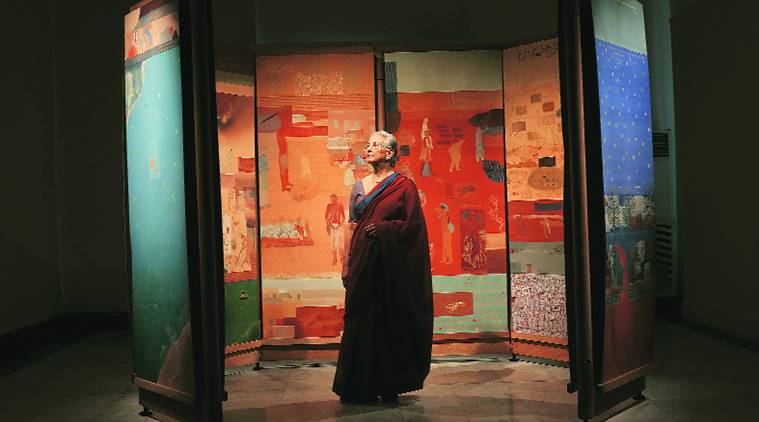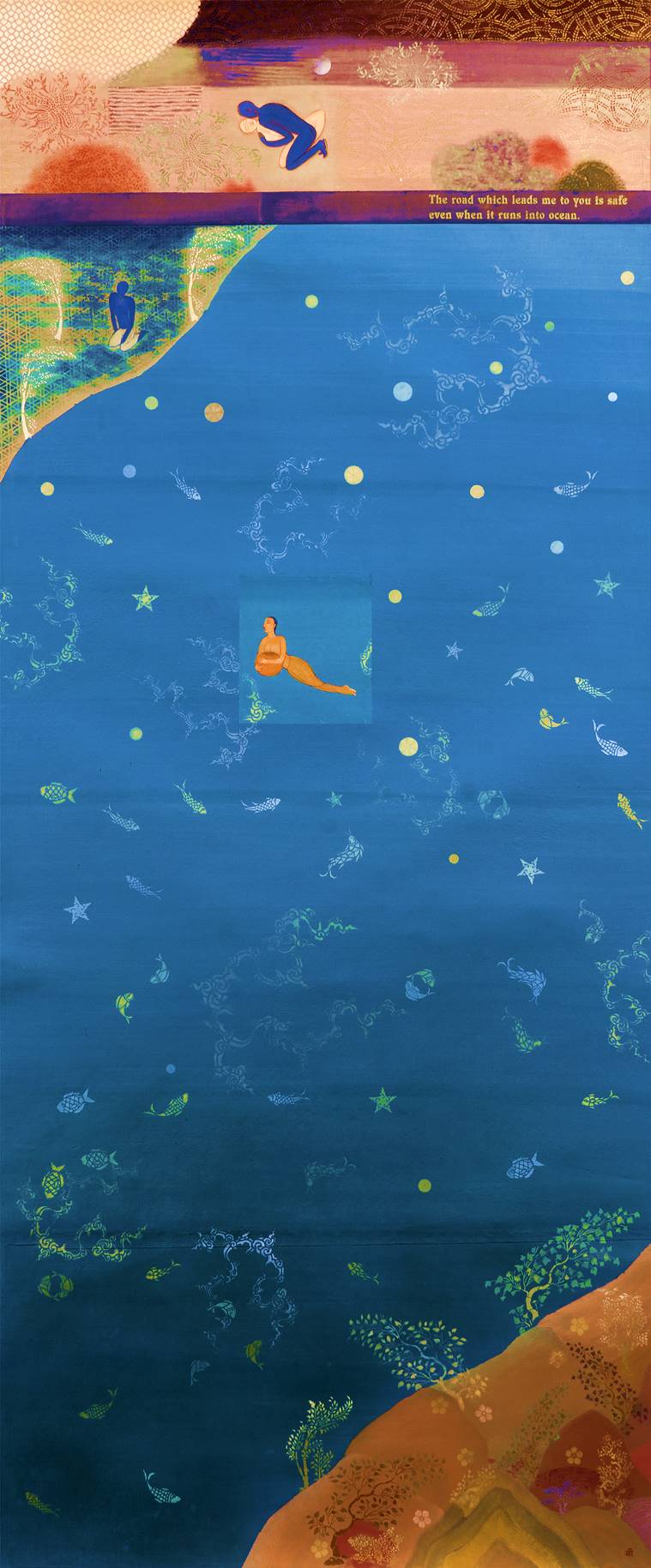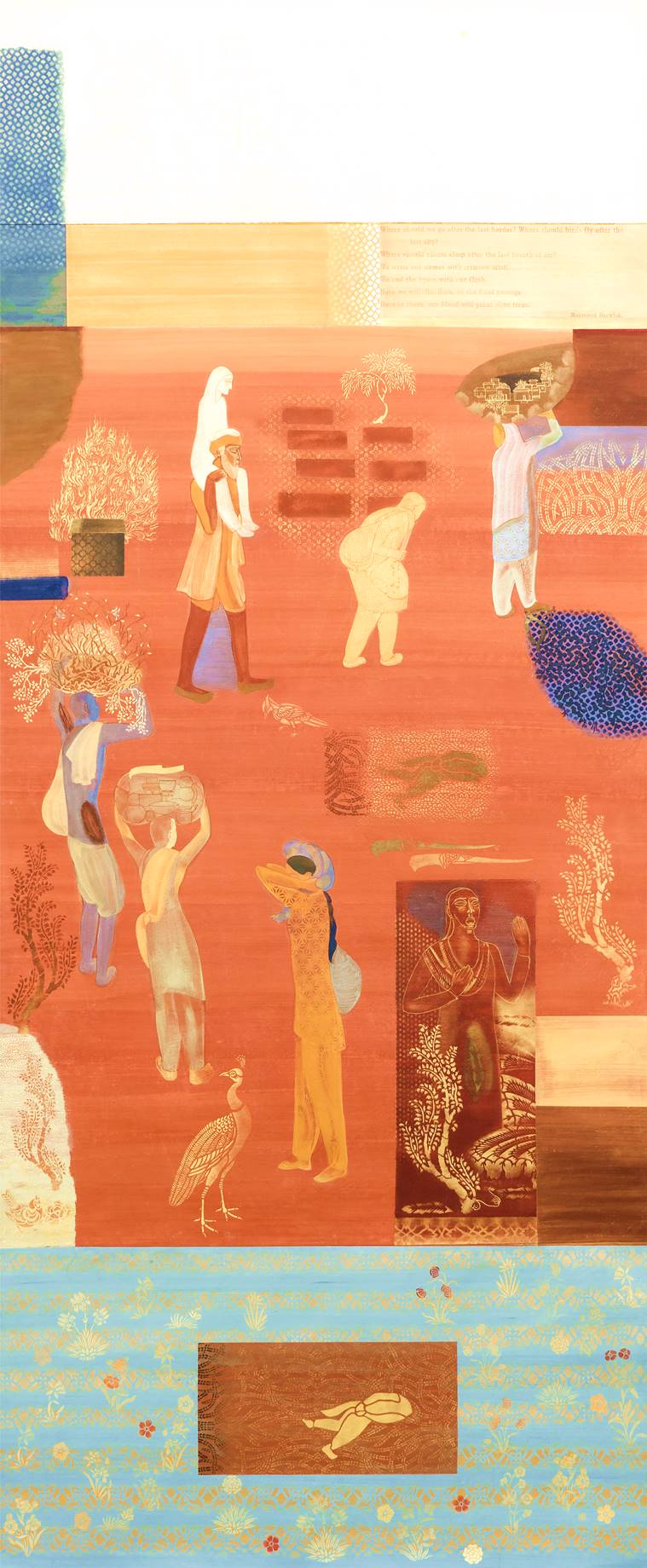My concerns are primarily about losing home: Nilima Sheikh
Artist Nilima Sheikh on her abiding interest in migration and revisiting Kashmir in her art. In this interview, she talks about her influences and being a woman artist in India in the 1980s.

Brushstrokes: Nilima Sheikh with panels of her artwork at Delhi’s Bikaner House.
Known for engaging with traditional Indian art practices and challenging existing modernist norms, Vadodara-based artist Nilima Sheikh, 73, continues to experiment with both medium and presentation. Last year, she received wide acclaim at Documenta 14. Her show of installations, Terrain: Carrying Across, Leaving Behind, concludes today at the Bikaner House, Delhi. In this interview, she talks about her influences and being a woman artist in India in the 1980s.
Edited excerpts:
Migration is an overriding theme in this series. Was it a conscious choice to make your art reflect it in view of the current global discussions around it?
My concerns are primarily about losing home. When you move on, you take some material belongings and leave behind others. You take some memories along too. In that sense, who is not a refugee? In the work, I go back in time, to the songs of Punjab that dealt with tragic stories where the protagonists were usually women (Sohni-Mahiwal, Heer-Ranjha) and in which patriarchy triumphed eventually. These were sung by men and are still sung in lands where there is preemptive killing of daughters, and where violence against women within the family is rampant. Even songs sung at marriages of daughters are about displacement. I use text from Gujarati and Punjabi literature that deal with this subject. I have also used a quote by (the late) Rohith Vemula, that speaks about the right to live.
My concerns are primarily about losing home. When you move on, you take some material belongings and leave behind others. You take some memories along too. In that sense, who is not a refugee? In the work, I go back in time, to the songs of Punjab that dealt with tragic stories where the protagonists were usually women (Sohni-Mahiwal, Heer-Ranjha) and in which patriarchy triumphed eventually. These were sung by men and are still sung in lands where there is preemptive killing of daughters, and where violence against women within the family is rampant. Even songs sung at marriages of daughters are about displacement. I use text from Gujarati and Punjabi literature that deal with this subject. I have also used a quote by (the late) Rohith Vemula, that speaks about the right to live.
Your pictorial narratives are reinforced with text. It began in 1984 with When Champa Grew Up (the story of a young girl, tortured and burnt by her in-laws). How does this marriage of the visual and the written word play out for you?
I feel, visual arts and literature don’t take away from each other. When Champa Grew Up was based on the life of a girl I knew, who played in the park with my children. When I was conceptualising the work, I tried to look for a format where I could tell the story page by page. In those days, artist books were fairly unheard of, at least in India, and I thought if I used a radically new form in the contemporary context, the focus would be on that rather than the fragile story I wanted to tell. There are several Indian storytelling traditions, many that still exist, like the regional variations of the patachitra, and while I was working on the series, Gulam (artist Gulammohammed Sheikh, her husband) found some poems and songs which were very close to what I was painting. I decided to use some within the format of the painting. It came as a bit of a shock to me that the anguish I was trying to record had already been expressed by women over the years in songs.
I feel, visual arts and literature don’t take away from each other. When Champa Grew Up was based on the life of a girl I knew, who played in the park with my children. When I was conceptualising the work, I tried to look for a format where I could tell the story page by page. In those days, artist books were fairly unheard of, at least in India, and I thought if I used a radically new form in the contemporary context, the focus would be on that rather than the fragile story I wanted to tell. There are several Indian storytelling traditions, many that still exist, like the regional variations of the patachitra, and while I was working on the series, Gulam (artist Gulammohammed Sheikh, her husband) found some poems and songs which were very close to what I was painting. I decided to use some within the format of the painting. It came as a bit of a shock to me that the anguish I was trying to record had already been expressed by women over the years in songs.
I believe in the 1970s, a senior artist questioned you on the need to show children in your paintings?
When I started making paintings with children in them, or making works on paper that were illustrative of life in my neighbourhood, it was just giving expression to the life that I led. So, when I was questioned, I thought: if artists can paint still lives, their lovers or anything else, why can’t I put my children in my paintings?
When I started making paintings with children in them, or making works on paper that were illustrative of life in my neighbourhood, it was just giving expression to the life that I led. So, when I was questioned, I thought: if artists can paint still lives, their lovers or anything else, why can’t I put my children in my paintings?

In 1985, you formed a collective with Madhvi Parekh, Arpita Singh and Nalini Malani, and held travelling shows of watercolours. Were the concerns of female artists different from their male counterparts?
The distinction between what a man might paint and what a woman might paint is not definitive. To bring the feminine into my work was, for me, very natural. This may have been the time when women started talking about themselves and looking at themselves, but it was also a moment in time where there was a struggle to find the means to express that. Arpita Singh’s work, for me, was inspirational. Not because I wanted to paint like her, but because she was an exemplar of this struggle. There was a sense of recognition we found in another woman artist’s work. There was divergence and sharing and we wanted to celebrate that. The act of exhibiting was helpful because we learnt to talk to each other about our work. It is only in hindsight that we realise we did something significant. In the following years, some understanding about how women’s art can be configured began to be available. In some sense, it was the practical informality of the exhibition — the choice of working on paper and travelling with the exhibition — that made it worthwhile. The medium of watercolour on paper was not really considered serious art at that time.
The distinction between what a man might paint and what a woman might paint is not definitive. To bring the feminine into my work was, for me, very natural. This may have been the time when women started talking about themselves and looking at themselves, but it was also a moment in time where there was a struggle to find the means to express that. Arpita Singh’s work, for me, was inspirational. Not because I wanted to paint like her, but because she was an exemplar of this struggle. There was a sense of recognition we found in another woman artist’s work. There was divergence and sharing and we wanted to celebrate that. The act of exhibiting was helpful because we learnt to talk to each other about our work. It is only in hindsight that we realise we did something significant. In the following years, some understanding about how women’s art can be configured began to be available. In some sense, it was the practical informality of the exhibition — the choice of working on paper and travelling with the exhibition — that made it worthwhile. The medium of watercolour on paper was not really considered serious art at that time.
Following the 2002 Gujarat riots, you began addressing concerns relating to the Valley in your work, at first, through Kashmiri expat poet Agha Shahid Ali’s verses from The Country Without a Post Office (2003). What makes you go back each time?
The violence in Gujarat was not necessarily the only catalyst for my work on Kashmir. Displacement has been one of my concerns for a long time but when you see things happening around you, you experience the fragility of the sense of belonging and are more empathetic to people who live through strife. As a child, I visited Kashmir several times. My parents were very adventurous and would trek on foot, off the beaten track. My visual and temporal understanding of space developed through these travels, some of which has translated into my negotiations with pictorial space. So, Kashmir was there in my work even before I actually acknowledged it. I was hurt and concerned about what was happening, but before I engaged directly with Kashmir, I had to do a lot of research and reading. I used the verses from Agha Shahid Ali’s books of poems, which also fed my interest in illustration. I felt he was leading the way. That was the beginning.
The violence in Gujarat was not necessarily the only catalyst for my work on Kashmir. Displacement has been one of my concerns for a long time but when you see things happening around you, you experience the fragility of the sense of belonging and are more empathetic to people who live through strife. As a child, I visited Kashmir several times. My parents were very adventurous and would trek on foot, off the beaten track. My visual and temporal understanding of space developed through these travels, some of which has translated into my negotiations with pictorial space. So, Kashmir was there in my work even before I actually acknowledged it. I was hurt and concerned about what was happening, but before I engaged directly with Kashmir, I had to do a lot of research and reading. I used the verses from Agha Shahid Ali’s books of poems, which also fed my interest in illustration. I felt he was leading the way. That was the beginning.
Every time a new aspect pertaining to Kashmir engages me, it encourages me to return to working on Kashmir. For instance, I was at the British Library in London in the summer of 2012, when I came across a 19th century manuscript with images of the working people of Kashmir, done by a Kashmiri hand, which encouraged me to work on a series of works on paper I called Rozgar. And later, a large canvas scroll titled Hunarmand.
In the 1980s, you researched the living traditions of art in India, particularly the Nathdwara Pichwai paintings. What prompted that?
I was interested in the Asian historical traditions of painting, not only in the miniature but also the mural and scroll painting traditions of India and the Himalayas, Tibet, China and Japan. I never received training in miniature painting techniques, but I have had opportunities to learn various tempera painting technologies. The research on Pichwai traditions was part of a Faculty of Fine Arts (MS University) project. It was not so much about learning the technique, but the technology — how are the paints made, the paintings structured, and how one kind of brush is used for a specific purpose. In India, it’s unfortunate that if we want a good pigment we have to search in artisans’ homes. And, for good quality handmade paper, go to Sanganer, Rajasthan. When I first went there, the situation of the papermakers was abysmal.
I was interested in the Asian historical traditions of painting, not only in the miniature but also the mural and scroll painting traditions of India and the Himalayas, Tibet, China and Japan. I never received training in miniature painting techniques, but I have had opportunities to learn various tempera painting technologies. The research on Pichwai traditions was part of a Faculty of Fine Arts (MS University) project. It was not so much about learning the technique, but the technology — how are the paints made, the paintings structured, and how one kind of brush is used for a specific purpose. In India, it’s unfortunate that if we want a good pigment we have to search in artisans’ homes. And, for good quality handmade paper, go to Sanganer, Rajasthan. When I first went there, the situation of the papermakers was abysmal.
In 1989, you were one of the founders of the artist collective Vivadi. You even designed the sets for theatre like Umrao (1994). Did that experience influence your art?
Very much indeed. We had workshops, staged productions. Working with the performing body in relationship to the large painted backdrops was really different from what one usually does. The collaborative element, and also the way large painted works were configured, influenced the large works that I make now.
Very much indeed. We had workshops, staged productions. Working with the performing body in relationship to the large painted backdrops was really different from what one usually does. The collaborative element, and also the way large painted works were configured, influenced the large works that I make now.
In what way have artists-teachers KG Subramanyan and your husband Gulam Mohammed inspired you?
KG Subramanyan was very active in Baroda during my student days, as a teacher, ideologue and an artist. He was interested in exploring Indian craft traditions, and a proponent for the absence of hierarchies in the world of art and craft. Even a shoemaker could be an artist. I also learned the language and grammar of visual art from him. Gulam taught me art history and brought alive the world of art for me. We have travelled together to look at art in museums and on site. I have seen him draw art itineraries for artist friends travelling to Italy, suggesting what road map to follow.
KG Subramanyan was very active in Baroda during my student days, as a teacher, ideologue and an artist. He was interested in exploring Indian craft traditions, and a proponent for the absence of hierarchies in the world of art and craft. Even a shoemaker could be an artist. I also learned the language and grammar of visual art from him. Gulam taught me art history and brought alive the world of art for me. We have travelled together to look at art in museums and on site. I have seen him draw art itineraries for artist friends travelling to Italy, suggesting what road map to follow.
For all the latest Eye News, download Indian Express App






















 Sheikh’s works from the current show.
Sheikh’s works from the current show.
No hay comentarios:
Publicar un comentario